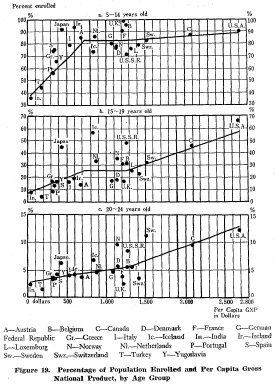| Home > Policy > White Paper, Notice, Announcement > White Paper > JAPAN'S GROWTH AND EDUCATION 1963 > CHAPTER |
||
The extent of the spread of education at each level of elementary, secondary and higher education has been reviewed in the foregoing for Japan and selected other countries. The average level of education and academic standards differ according to country, however, and such factors affect relationships between education and economic status in the several countries. For this reason, Figure 19 presents, for Japan and 23 other countries, data showing the per capita gross national product (in dollars) of each in relation to the percentage of total population in three major age-groups enrolled in school. The age groups used are 5-14, 15-19 and 20-24. The figures for European countries, the U.S.A. and the U.S.S.R. are cited from the materials of the Organization for Economic Cooperation and Development.

It is clear from Figure 19 that there exist certain relations between the spread of education and the development of economy. Moreover, the higher the age group becomes the closer the relations become. It can easily be imagined that in the countries where per capita gross national product is still low, people cannot forego the income, which could have been earned, by having their children advance to full-time upper secondary schools or further to universities, after completing compulsory education. It is also understandable that in the countries with highly developed economy and higher per capita gross national product, the social demand for higher level of school education becomes stronger and individual households can afford educational expenses as a consumption.
In the three countries with the highest per capita gross national product (the U.S.A., Canada and Sweden) the percentage of school enrol1ment is very high, especially in the age groups of 15-19 and 20-24 years old. On the contrary in the Mediterranean countries with considerably low per capita gross national product the percentage of school enrollment is also low.
Here, attention should be drawn to the percentage in the countries, such as the U.S.S.R., United Kingdom, France, German Federal Republic and Japan, where per capita gross national product is in the middle. It is to be noticed that these countries with equal extent of economic development, differ considerably as to the percentage of school enrollment at each level of education. From this fact it may be seen that in the countries which have reached certain living standard, with their per capita gross national product in the middle, difference in the efforts for education results in the difference in the percentage of school enrollment.
The fact that the school enrollment ratio in Japan and in the U.S.S.R. is exceeding great1y those estimated from their economic standard shows that these countries are, traditionally or by policy, making great effort for education.
| Back to Top | MEXT HOME |